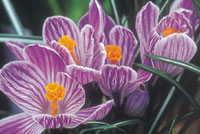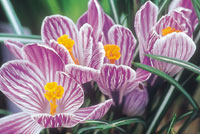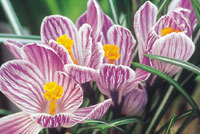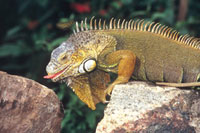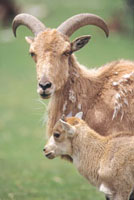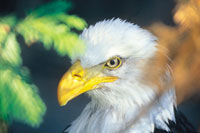In The Field
Top 10 Accessories For Nature Photography
Every avid outdoor photographer has discovered some key accessories which help to solve problems in the field. Whether through trial and error, from reading about photography, or with the guidance of a workshop instructor, these soon become an integral part of his or her arsenal. Helping to overcome technical difficulties, the best devices are useful for problem solving or preventing frustration. While creative vision is essential in the photographic process, the following accessories can help to assure greater technical achievement or increased convenience in the field. 1. A lightweight/rigid support. Some photographers are not yet convinced that a 3 to 4 lb carbon-fiber tripod is suitable for serious photography. They firmly believe that "only mass provides stability" and will buy the heaviest tripod they can find. If you fall into that category--or if you routinely photograph wildlife with a 13 lb lens like a 400mm f/2.8 telephoto--you may wish to stick with a massive tripod. However, for many other types of photo equipment, the popular carbon-fiber models--light in weight but rigid--are worth considering. Because they are more portable, they are more likely to see frequent use, increasing their potential value as a useful accessory. Before buying one, do check the specifications as to the amount of weight each model is capable of supporting. If you frequently shoot with a 500mm f/4 telephoto, don't pick the model that's intended for backpackers with compact camera equipment. Like any tripod, the carbon-fiber models provide the most stable platform for camera equipment when used intelligently. Extending the center post more than a few inches creates a monopod on three legs, so it is not generally recommended. During days with strong wind gusts, there is less risk of equipment shake if you shoot from an even lower level; extend only the top section of the legs. In ground level photography, extending all of the legs reduces stability; it also increases the risk of damage to the tripod. For maximum security, extend only the top section (with the widest diameter tubes) when using this shooting technique. |
||||
2. A
vibrationless release device. No matter how rigid the tripod,
triggering the camera can induce vibration which will defeat all of your
precautions. Consequently, a cable release should be considered essential--to
trip the shutter without jarring the camera. In the past, a standard mechanical
cable fit virtually every SLR, threading into the center of the shutter
release button. However, most of today's cameras require an electronic
cable switch or an infrared wireless remote controller; check your Owners
Manual for the correct model. Use one of these with mirror lockup--if
your SLR is so equipped--for vibrationless photography especially with
long exposures or when using telephoto lenses.
3. A great tripod accessory. Although the tripod is acknowledged as essential for serious photography, it's not exactly renowned for speed of operation. When the light is rapidly changing, what is more exasperating than missing the decisive moment while fumbling to switch to another camera or lens? Screwing equipment on and off is not only tedious, but when you're done, the lens is probably pointing in the wrong direction. Fortunately, the entire process can be facilitated with a quick release mechanism. This is a truly efficient and practical alternative to the otherwise time-consuming chore of changing cameras or lenses. While you'll find numerous types and configurations on the market, the basic concept is essentially quite similar. All start with accessory plates which attach to the tripod socket of your cameras, or the foot of the mounting collar of some heavy telephoto lenses. The plate simply plugs into a bracket built into some tripod heads or sold as an accessory. Changing equipment on a tripod now takes only seconds, making the quick release devices invaluable in terms of speed and convenience. |
||||
4. Alternatives to the tripod. The most effective blind for certain wildlife and birds is your automobile, especially on safari, in national parks and some refuges. Some photographers will rest a mini tripod or a beanbag on the window sill of their vehicles. This tactic--or a lightweight window mount from a tripod manufacturer--is often useful for shake-free exposures with lightweight telephotos like the 400mm f/5.6 models. But for longer exposures or when using super telephoto lenses, a larger window mount will better exploit the stability of your vehicle. For heavy pro telephotos (like the 600mm f/4) check out the pro models like the Kirk Enterprises Window Mount constructed of black anodized aluminium. Its lip grabs either the glass or the window groove; the base which hugs the interior of the door provides additional support. Add a sturdy ball-and-socket head which will allow the lens to be pointed in any direction. For long lenses in difficult conditions, such as shooting from a helicopter, try Ken-Lab's "invisible tripod" the Kenyon Gyro Stabilizer. |
||||
5. Stabilizing devices. Ever wonder how an archer with a crossbow can hit the bull's eye every time? He's no more steady than you or I shooting with a 400mm f/5.6 telephoto, but he has one advantage: a gunstock. With a design proven successful through generations, combined with the perfect stance for shooting, the stock assures precise accuracy, with minimal shake. You'll find various "shoulder mounts" including those from the Kirk Enterprises catalog and others in our mail-order ads. Shapes, sizes, and construction vary, so your choice will depend primarily on personal preference. 6. A supplement to sunshine. Although some nature photographers will use flash only as a last resort, an electronic flash unit is high on my list of favorite accessories. Ambient light during much of an even splendid day can be harsh and overly contrasty, with hard shadows cast over the subject. Then there are the dark, overcast days and the deep woods with heavy foliage blocking the sun. In such circumstances, a fine-grained slow (ISO 50 to 100) film is impractical without flash, unless you're using a tripod and your subject remains perfectly still. By relying on flash, you can expand the "window of opportunity" from perhaps four hours per day to many more. Past experience with full flash outdoors has led many photographers to believe that the effects are "artificial." They find that the lighting appears harsh, the shadows hard, and backgrounds often unnaturally dark. Thankfully, the current high tech cameras--with a dedicated multimode TTL flash gun--can help to achieve beautiful pictures without tedious calculations. This is accomplished primarily by an "intelligent" metering system that automatically reduces flash output by about 1.5EV in bright conditions. Some high-end flash units and cameras even allow you to further reduce flash intensity for a particularly natural effect. Sunlight remains the primary illumination with the extra burst of light providing fill-in lighting only. The artificial flash look becomes a thing of the past. The extra illumination can "fill-in" shadows or even out the lighting for a more pleasing, less contrasty effect. Use it to brighten the center of interest in backlighting, help to fully saturate colors, and to add a catchlight to the eyes of birds and animals. When using 300mm or longer lenses, a Fresnel screen accessory can be invaluable for increasing the effective "reach" of flash. Several companies market such devices, with the best known made by Visual Echoes (the Flash X-Tender.) |
||||
7. Remote Flash Accessory. While on-camera fill flash can work nicely for subjects which are 10+' from the lens, those which are much closer can benefit from remote flash placement. In macro nature photography for example, the light from a hot shoe-mounted flash will illuminate an area beyond the subject even if the reflector can be tipped downward. Removing the flash unit from the body can solve this problem. In order to maintain full TTL flash control, most SLR cameras now accept a TTL extension cable to extend their dedicated features from the hot shoe to a remote flash unit. A few camera/flash combinations provide Wireless TTL Remote Flash control and Ikelite makes an accessory TTL Slave Sensor that achieves the same effect with Canon or Nikon flash units. You can now hold one or more light sources exactly where desired, and let the system handle exposure calculations for you. 8. A third hand. Some photographers hold an off-camera flash unit in their hands--above and to the side of the subject--but this can be somewhat awkward. Off-camera flash is more convenient when the unit is mounted on a bracket like those used by news and wedding photographers. For wildlife photography, look for a bracket which gets the flash as far from the lens axis as possible because redeye in animals is prevalent with on-camera flash, even outdoors. There are dozens of brackets on the market from camera and flash manufacturers as well as independents: Adorama, The Tiffen Company, Kirk Enterprises, and Hasselblad. (For extreme close-up work, look for a model that is specifically advertised for this application.) All are adjustable so you can control the direction of lighting as well as the shadows; try placing one or two flash units in a slightly different position for each frame of a series. |
||||
9. Contrast control accessories. In spite of the advantages of fill flash, some photographers prefer to rely on ambient light only. Thankfully, the accessory manufacturers offer a broad variety of devices which make this approach feasible. Their most valuable are the reflector panels, used for bouncing extra light into essential subject areas, such as the pistil and stamen of a deep blossom. Homemade accessories can be used, but I prefer the more durable alternatives like the gold/silver and silver/white reflectors you see listed in several of our mail-order ads. Available in various sizes and color combinations for creating pleasing effects, these fold down to a third of their working size for maximum portability. A 32" silver/gold reflector is my most frequently used accessory as it offers a variety of benefits: especially fill-in for contrast control, plus modification of the color and quality of light. For nature close-up photography in harsh, contrasty light, consider a diffusion screen: a translucent cloth panel that helps to provide softer, more pleasing light. (These are offered by many of the manufacturers of reflector panels.) Simply hold it between the sun and your subject to provide diffusion. If desired, use a reflector as well, to bounce some extra light onto an essential subject area. Note: When using any of these contrast control accessories, take the light meter reading only after the panel is in place; this will avoid overexposure (with reflectors) or underexposure (with diffusion screens). 10. An alternative to macro lenses. One of the best accessories for extreme close-up nature photography--with the highly popular tele-zoom lenses--is the "supplementary close-up lens." Resembling a filter with magnifying glass, this accessory can substantially reduce the minimum focusing distance of a lens (by shortening the effective focal length). Available in various diopter strengths, these have several advantages over extension tubes, especially with zoom lenses: they are smaller; there's no loss of light (for ease of focusing and for faster shutter speeds); magnification can be increased by simply shifting to a longer focal length; and focus does not shift as you zoom the lens. Granted, these accessories are not intended for magnification beyond 1x (or "life-size") and when used with a zoom lens they do not match a true macro lens in terms of optical quality. Still, they are more convenient than extension tubes and less expensive than macro lenses. Start with a lens of known high quality, use professional techniques to avoid camera or subject movement and stop down to f/11 to f/16. And be sure to look for the "double element" or "achromatic" supplementary (or "auxiliary") close-up lens kits because these are effectively corrected for optical aberrations. Conclusion. If any of the accessories surveyed seem to hold potential for your own nature photography, shop around. Check our mail-order ads, request a catalog, or check the pertinent web sites. There are numerous models available from a broad variety of manufacturers, with one just right for your own preferences. I have mentioned only a few as examples, but there is a vast range of accessories out there--all designed to make photography successful and more convenient as well. Manufacturers/Distributors Adorama Inc. Hasselblad U.S.A., Inc. Ikelite Ken-Lab, Inc. Kirk Enterprises The Tiffen Company Visual Echoes |
